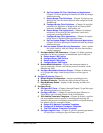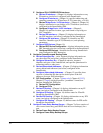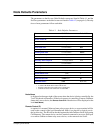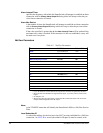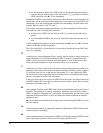
Configuring Node Defaults 4-5
Secondary Alarm Output ID
is used for a collecting node to send alarms to a second location other than that spec-
ified by the
Primary Alarm Output ID
. This parameter has no function on non-collecting
nodes.
Secondary Alarm Output Pwd
is a password that will be used if the
Secondary Alarm Output ID
is an address that is
also associated with a password. If so, both passwords must match.
Collecting Node
is a SmartSwitch 1800 or other Cabletron frame relay access device to which alarms
are sent from other Cabletron frame relay access devices. Any SmartSwitch 1800,
9W004, FRX4000, or FRX6000 can be a collecting node; which nodes send their
alarms to a collecting node is determined by the
Primary Alarm Output ID
s and pass-
words of the other nodes; these must match the
Collecting Node ID
and password of
their collecting node.
The number of nodes that can report to a collecting node depends on the number of
connections that can exist on the collecting node. (A SmartSwitch 1800 supports up
to 512 connections.) A connection on a collecting node is required for each reporting
device.
Do not configure a collecting node to send its alarms to another
collecting node. The alarms will be ignored, due to a format mis-
match.
Max Congestion
is a percentage of the SmartSwitch 1800 alarm buffer. If this level is exceeded, no
more alarms will be put into the buffer until it has reached the specified
Min Con-
gestion
. (See that entry below and "Alarm Buffer" on page 22-2.)
Min Congestion
is a percentage of the SmartSwitch 1800 alarm buffer. As long as the percent of the
buffer that is full is below this level, alarms will always be placed into the buffer. (See
"Alarm Buffer" on page 22-2.)
Periodic Status Timer
sets the frequency with which the SmartSwitch will send a "heartbeat" alarm message
containing the date and time. The heartbeat serves as a verification that the Smart-
Switch is operational.
Line Idle Timer
is a period that an SVC alarm connection will remain active after an alarm message is
sent. If no alarm is generated during this time, the alarm connection is cleared. The
Periodic Status Timer
(see that entry) determines the frequency with which routine
status messages for this SmartSwitch will be sent. On a reporting (non-collecting)
node, it is generally preferable to set the
Line Idle Timer
to a period longer than the
Periodic Status Timer
, to give the system a chance to update itself. The timer is usually
set to
0
on a collecting node.
The
Line Idle Timer
is also affected by the value of
Max Congestion
(described on page
4-5).



